I had rum and a dead man to thank for my treasure map. Maybe 20 years my senior, Dave was a summer neighbor. One balmy July evening he hailed me across our yards.
“Come on over,” he called. “I’m making daiquiris.”
Dave knew his way around the construction of a proper cocktail. His daiquiris were paradigms of tart-sweet simplicity—white rum, lime juice, superfine sugar, ice—and they went down as silkily as hookers in Havana. Pretty soon our tongues were wagging, and I started blathering about an upcoming trip to Ontario’s Lake of the Woods.
“Fly fishing for smallmouth bass,” I gushed. “It doesn’t get any better than that.”
A dreamy look came over Dave’s face, a look not entirely attributable to the rum. “Fly fishing for smallmouth,” he said, wistfully. “God, I haven’t done that in years. I used to wade _____ Bay with my fly rod and catch smallmouth like you wouldn’t believe.”
More Like This
This piece of intelligence pierced the alcohol haze like a laser beam and burned straight into my brain. Suddenly, I was all ears. I was familiar with the bay he’d named, much of it a vast marl flat dotted with beds of hardstem bulrush. It didn’t look like smallmouth water—there were hardly any rocks, for one thing—and I’d never heard of anyone fishing bass there.
“_____ Bay?” I said, trying to sound casual but lusting for further details. “Really?”
“Oh, yeah,” Dave replied, reaching into the bucket for more ice. “They move in from Lake Michigan in the spring. There’s a window—late May, early June—when they’re in the shallows and you can get at them with flies. After that they drift back to deep water.”
Needless to say, this information went directly to a high-priority memory file, hot-flagged with the notation “Check out next year.”
Which I did. The daiquiris may have lubricated the mechanism but Dave hadn’t been bullshitting me: The first time I fished what I’ll henceforth refer to as the Bay of Pigs, I caught what was then, by a wide margin, the biggest smallmouth of my life.
She was cruising and feeding, and at first I assumed it had to be a carp, great herds of which (somehow “schools” seems too civilized) roam there. Nothing that big could be anything else. But then she arrowed up to eat something, perhaps a mayfly nymph rising out of the marl, and I went cotton-mouthed, rubber-kneed—all the usual responses when you realize you’re in the presence of something outrageously desirable that, if you don’t mess it up, you have a chance to attain. Thankfully it was an easy cast, and after dropping the Woolly Bugger in the general vicinity and twitching it once or twice the bass took without hesitation.
It was one of those fights you don’t retain much memory of—and you can’t honestly say you enjoy—because you’re fixated, to the exclusion of all other thought and stimuli, on just landing the damn fish. When she came to hand and I could see her out of the water, her dimensions were even harder to wrap my mind around. It was as if she were a member of a mutant race, a race unknown to ichthyological science. She superficially resembled the smallmouth I was familiar with—glowering red eyes, barred olive flanks, mouth like coarse-grit sandpaper, the basic shape and fin arrangement characteristic of the sunfish family—but she was enormous. She looked more like some kind of snapper or grouper than a smallmouth bass.
In a perfect world I would have showed up at Dave’s door with a bottle of Bacardi to thank him for leading me to the smallmouth of my dreams. But the world isn’t perfect: A few weeks after we’d shared those daiquiris, Dave lost control of his car on a rural highway and plowed into a stand of trees.
I raised more than a few toasts to his memory—and hoped like hell that in acting on his tip I hadn’t exposed my soul to the same bad karma.
This isn’t “technical” fishing but it isn’t as easy as you might think. You need to place a pretty heavy fly on a pretty small target, there’s always wind to contend with, and to further complicate matters these inshore Great Lakes waters are affected by a natural phenomenon called a seiche. A seiche behaves superficially like a tide but, as a function of differential pressures created by offshore wind- and wave-action, it’s much more erratic and unpredictable. (There are no “seiche charts.”) The kicker is that the seiche can change any number of times over the course of a single day or even a few hours, running out, then in, then out again, and so on.
It’s not at all uncommon to have the wind and waves punishing you from one direction while the seiche is running briskly in the other. Making a good cast
in these conditions not only requires tight loops, high line speed, and all the other gambits from the Lefty Kreh playbook (including knowing when to duck) but a working knowledge of vector mechanics and non-Euclidean geometry.
So yes, you need to have some skills—although frankly we don’t do it for the challenge. We don’t do it for the fight, either. Oh, these fish’ll usually give you a crashing leap or two, some heavy threshing on the surface, and a few hard pulls, but they don’t display remotely the same conviction or resolve of a midsummer smallmouth.

No, the reason we do it, the reason we’re powerless to resist the Bay of Pigs’ siren song, is that for a couple of weeks every spring it affords us the chance to stand in the water and catch smallmouth bass that are just crazy, silly, stupid big—on fly rods. That’s right: It’s all about the size. I suppose this could be the expression of some primal urge deeply encrypted in our DNA—but I think it’s equally likely that it’s yet another manifestation of our eternal adolescence, burbling from the same dubious spring that makes us incapable of not gawking like halfwits when a terrific set of knockers heaves into view.
On the Bay of Pigs, you can find every variety of swine.
Speaking of farm animals, there was the time I waded out toward a large, ochreous rock that appeared to be about a third out of the water. I couldn’t remember seeing it before but it’s not uncommon for ice to re-arrange the furniture in these parts, so it didn’t strike me as unusual. The rock seemed to be creating some curious-looking ripples, too, but I figured it was just another of those perplexing seiche events.
As I waded closer, though, stripping line in preparation to cast, the rock appeared to flex. Then it appeared to flex in the opposite direction—and I realized that the rock was a massive carp, semi-beached in the skinny water. I’ve caught carp that pushed 30 pounds but this fish was an order of magnitude larger. It looked almost mammalian—as if, in the middle of attempting to make an evolutionary leap, the carp had high-centered itself.
At this point, however, it was ready to return to its natural element. While I maintained a respectful distance it wallowed in the marl, struggling to break free
and attain enough buoyancy to swim. It finally slouched away, a porcine beast trailed by its cloud of natal mud.
The last time I fished the Bay of Pigs, I arrived around nine in the morning, hoping to take advantage of the midday sun. The funky old cottages perched above the water—glorified shacks, really—were still shuttered up; the only traffic on the bay was a pair of mute swans, floating cloudlike along the far shore.
I was stringing my rod when a compact pick-up crunched to a stop behind my Jeep. A youngish guy wearing Clark Kent glasses jumped out and breathlessly asked “Are you coming or going?”
I wanted to say “Relative to what?” but I just said “I’m getting ready to go fishing, if that’s what you mean.”
“OK!” he said. Then, faster than I imagined possible, he was wadered up and, spinning rod in hand, literally running through the shallow water along the shoreline—in precisely the direction I’d planned to go, of course.
A fishing companion once described my demeanor during a run of bad luck as “stoic, but pissed.” Yep.
But, what the hell. I knew I’d find bass; I’d just have to cover more water and hunt a little harder, is all.
That’s pretty much how it went down. An amoeboid shadow on the bottom of a deep trough looked intriguing, and when I dropped a crayfish pattern on it a portion of the shadow detached. The fly came to a stop at the same time and when I reared back I felt that glorious throbbing weight, immovable but not quite, that, to me, is the money shot. The bass eventually lurched out of the water, shook its head, and threw the hook, but I’d gotten what I’d come for.
The next fish was in a more conventional spot, near the edge of a stand of broken-down bulrushes. The fight was a twin to the first: that lovely sensation of mass when the line came tight, some bucking and thrashing, and ultimately a long-distance release.
I went through a dry spell after that, making an ambling clockwise loop aross a goodly section of the flat, playing connect-the-dots with the scattered bulrush stands but coming up empty. The sky above was sunny, but a cottony layer of fog was building on Lake Michigan, and if it pushed into the bay (as I suspected it would) I’d have to pull out. There was a bulrush stand all by itself beyond a swale of deeper water, and after tip-toeing across to get in casting range I took aim and lobbed the crayfish. It plunked down exactly where I wanted it to.
Unlike the others, this bass stayed hooked. She was one of those fish you stare at numbly for several seconds before shaking your head in utter disbelief and mumbling some profundity like “Jesus Christ.”
I clambered ashore just ahead of the fog. By the time I’d peeled off my waders and broken down my rod, you couldn’t tell where the land ended, or where the water began.
Clark Kent had already flown.





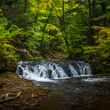





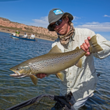








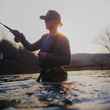
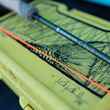



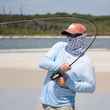
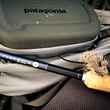

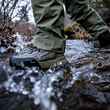



Comments